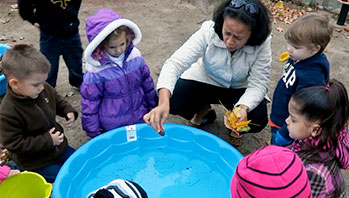- clipboard
- marker
- afraid
- explore
- friend
MA Standards:
Speaking and Listening/SL.PK.MA.1: Participate in collaborative conversations with diverse partners during daily routines and play.
MA Draft STE Standards
Life Sciences/From Molecules to Organisms/LS1/3.C: Use their sense in their exploration and play to gather information. [Structure and Function]
Life Sciences/Ecosystems/Biological Evolution/LS2/4.E: Predict where they might find a familiar plant or animal and explain why they think so based on experience and knowledge of the organism. [Patterns]
Head Start Outcomes:
Language Development/ Expressive Language: Engages in communication and conversation with others.
Science Knowledge/Scientific Skills & Method: Participates in simple investigations to form hypotheses, gather observations, draw conclusions, and form generalizations.
Science Knowledge/Conceptual Knowledge of Natural & Physical Worlds: Observes, describes, and discusses living things and natural processes.
PreK Learning Guidelines:
English Language Arts 2: Participate actively in discussions, listen to the ideas of others, and ask and answer relevant questions.
English Language Arts 3: Communicate personal experiences or interests.
English Language Arts 15: Use their senses of sight, hearing, touch, smell, and taste to explore their environment using sensory vocabulary.
Science and Technology 1: Ask and seek out answers to questions about objects and events with the assistance of interested adults.
Science and Technology 10: Observe and identify the characteristics and needs of living things: humans, animals, and plants.
Science and Technology 15: Use their senses of sight, hearing, touch, smell, and taste to explore their environment using sensory vocabulary.
Health Education 16: Recognize and describe or represent emotions such as happiness, surprise, anger, fear, sadness.
Explore Together (outdoors): Exploring With Friends

© Commonwealth of Massachusetts, Department of Early Education and Care. All rights reserved.
Safety Tips:
- Be aware of and check areas for poison ivy, poison sumac, nettles and thorns before taking children outside.
- Remind children to wash their hands before and after the activity.
- Remind children not to eat ANY plants or touch any plants without asking an adult.
- Children’s allergies need to be taken into account before going outside.
Talk about how friends do things together and learn things together.
Discuss how Peep learns about trees and hummingbirds from Chirp and Quack, but he also learns to be afraid of the cat before he talks to the cat.
Discuss how Peep felt after he talked to the cat. Explain that things can seem less scary or different after you learn more about them. Ask questions such as:
- Did you ever feel afraid of something before you tried it or saw it?
- Did you feel afraid the first day you came to school? How do you feel when you come to school now?
Tell children that they are going to go outside and explore with a partner to learn more about things that live in and around trees. Before heading outside, ask children to name some animals and insects they have seen around trees in their neighborhood. (birds, worms, insects, squirrels.)
- Write children’s ideas on a clipboard.
- Have them predict which of the animals they think they will see today.
- Say, Let's see if we can learn something new or different about the things that we observe today.
Then take the children outside. Listen and engage with them when you notice something sparks their interest. Ask questions such as:
- What do you notice about its <body/head/eyes>? What about the way it <moves/jumps/crawls>?
- Where do you think it’s going? What is it doing? How is it moving?
- What does it sound like? What do you think it feels like?
Reflect and Share Together
Once inside, compare the list of predicted creatures with the list that the children actually saw. Ask questions that encourage children to describe and share their observations, such as:
- Were there any animals you didn’t see that you thought you would see?
- Did anything surprise you about the animals that you did see?
- Were you afraid of <ants> before you watched them closely today? Are you still afraid of them?
Educator Tip: Some children may not have the right words to accurately describe how they are feeling. Be cautious of answering for children and labeling their emotions too soon. Teach a variety of emotion words so children can describe when they are frustrated, anxious, or embarrassed.
Educator Tip: Be aware if a child is afraid of an animal or insect they are likely to see outside. You may want to stay by the child as he or she observes the animal or lead him or her to another area to explore.
